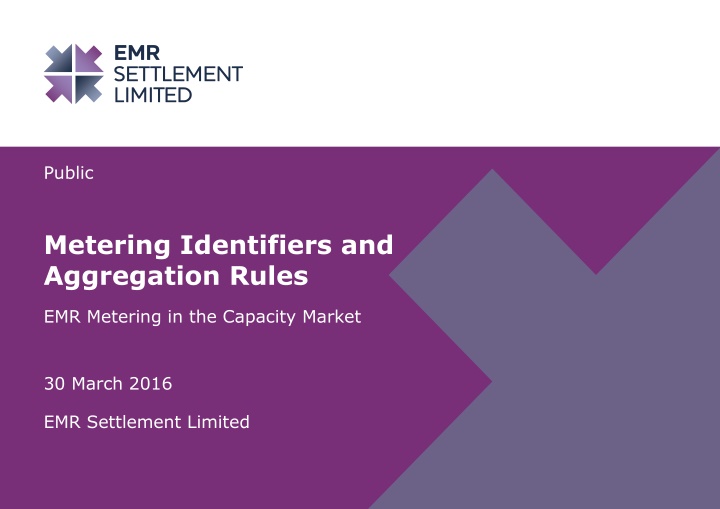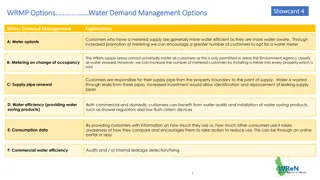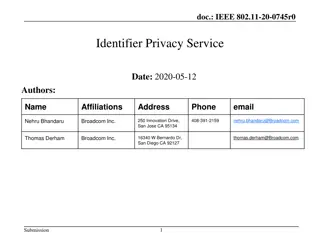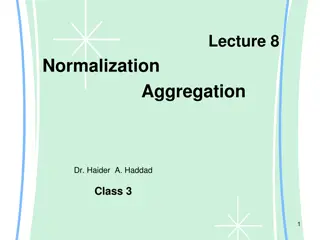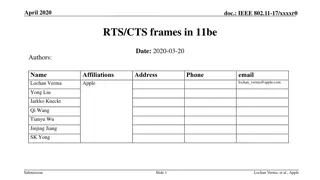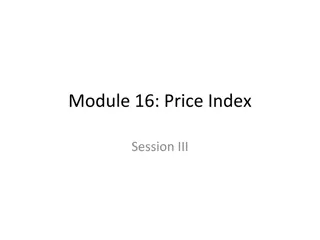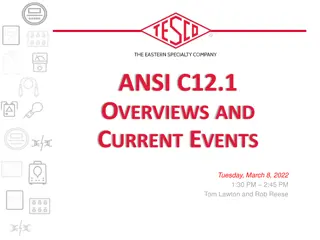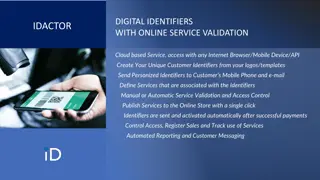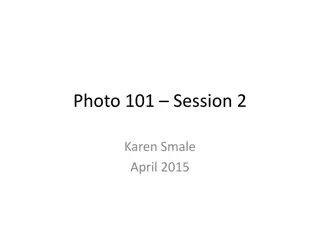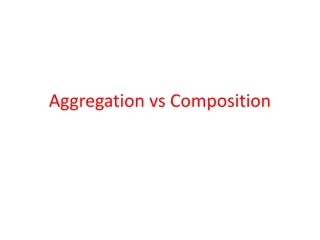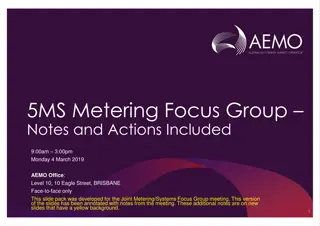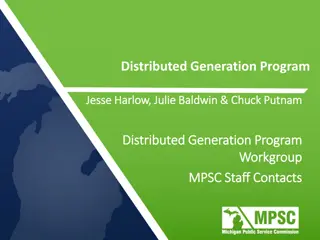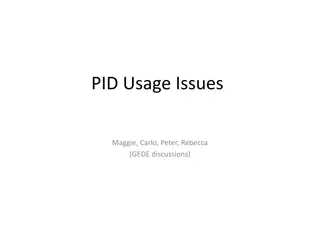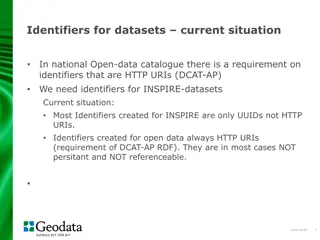Metering Identifiers and Aggregation Rules
This content covers the importance and rules surrounding public metering identifiers and aggregation in the capacity market. It delves into the specifics of EMR metering and settlement processes. Understanding these concepts is vital for effective participation in the market and ensuring compliance with regulations.
Download Presentation

Please find below an Image/Link to download the presentation.
The content on the website is provided AS IS for your information and personal use only. It may not be sold, licensed, or shared on other websites without obtaining consent from the author.If you encounter any issues during the download, it is possible that the publisher has removed the file from their server.
You are allowed to download the files provided on this website for personal or commercial use, subject to the condition that they are used lawfully. All files are the property of their respective owners.
The content on the website is provided AS IS for your information and personal use only. It may not be sold, licensed, or shared on other websites without obtaining consent from the author.
E N D
Presentation Transcript
Public Metering Identifiers and Aggregation Rules EMR Metering in the Capacity Market 30 March 2016 EMR Settlement Limited
Metering Information A Capacity Provider must complete the Metering System Information table (see below) This is to be completed for each CMU they are responsible for and for each Component making up those CMUs The information provided will be used as the basis for aggregating Metered Volumes in the EMR Settlement System Boundary Point MPAN / MSID Balancing Services ID Row No. Component ID Effective Date Metered Entity Type Metered Entity Id Multiplier Distributor LLFC ID CMU ID ID 1 The CMU ID is as specified in the Capacity Market Register The CMU Component ID will consist of Unit# (where # starts at one and increments for each Component making up the CMU) Metering Identifiers and Aggregation Rules 2
Metering Information The effective date is the start date of the relevant Delivery Year The Metered Entity Type will be one of three options: BMU for all CVA Metering Systems MPAN for the Supplier Settlement Metering Option MSID_NON_BSC for Balancing Services and Bespoke Metering Options BMUs being split will be treated as Bespoke (i.e. MSID_NON_BSC) The Metered Entity ID will be: The BMU ID for BMU Type The MPAN for Supplier Settlement Metering Option The identifier for the Metering System for MSID_NON_BSC Metering Identifiers and Aggregation Rules 3
Metering Information The multiplier will be: 0.00<x< 1.00 for a shared demand BMU +1.00 for everything else (apart from non-CM generation that needs to be netted off, e.g. ineligible low carbon generation, then it would be -1.00) Auxiliary Load must be a proportion of a HH Metered Volume (e.g. a BMU) or separately Metered (i.e. a Bespoke Meter) The Distributor ID is a four character reference to identify the Distributor of the Boundary Point Metering System Only required for Bespoke or Balancing Services Metering Option Metering Identifiers and Aggregation Rules 4
Metering Information The Line Loss Factor Class (LLFC) ID is a three digit reference that identifies the Line Loss Factor (LLF) to be applied to Metered Volumes Only required for Bespoke or Balancing Services Metering Option The Boundary Point MPAN / MSID is the identifier for the Boundary Point Metering System Only required for Bespoke or Balancing Services Metering Option MSID is only relevant if CMU is embedded within a BMU connected to a Distribution System The Balancing Services Contract ID is the reference identifier for any Component that has a Balancing Services agreement with National Grid Metering Identifiers and Aggregation Rules 5
Metering System Identifiers: CVA/BMU CVA Sites are always BM Units The Metering System Identifier is a BMU ID The Aggregation Rule will consist of BMU IDs There can be multiple BMU IDs making up a CMU Transmission connected BMU IDs begin with T_ and Distribution connected BMU IDs begin with E_ A CMU can consist of T_ and E_ BMU IDs, for example if there is a Distribution connected Demand circuit There can be a multiplier applied to Demand BMUs that are used by separate Generating Units Any CMU that is splitting a BMU becomes a Bespoke Metering Configuration Solution and requires a Metered Entity Identifier Metering Identifiers and Aggregation Rules 6
BM Unit Metering Systems The following slides got through some examples The line diagram below represents a typical Generating Station 275kV 17kV X BMU T_EFGH-2 BMU T_EFGH-1 Generating Unit demand for Electricity Generating Unit demand for Electricity MU1 MU2 BMU X X X T_EFGH-D 17kV 415V 17kV 415V Station Transformer Board MST MG1 MG2 X X G G 17kV 17kV 17kV 300MW 300MW 415V 415V 415V Other Station load (e.g. office supply) Metering Identifiers and Aggregation Rules 7
BM Unit Metering Systems In the first example each Generating Unit is a CMU CMU ID1 is EFGH-1 (Generating Unit 1 T_EFGH-1) CMU ID2 is EFGH-2 (Generating Unit 2 T_EFGH-2) The Demand BMU ID is T_EFGH-D The same Demand BMU ID is used by multiple CMUs Boundary Point MPAN / MSID Balancing Services ID Row No. Component ID Effective Date Metered Entity Type Metered Entity Id Multiplier Distributor LLFC ID CMU ID ID 1 EFGH-1 01/10/2018 BMU T_EFGH-1 1.00 2 EFGH-1 01/10/2018 BMU T_EFGH-D 0.50 3 EFGH-2 01/10/2018 BMU T_EFGH-2 1.00 4 EFGH-2 01/10/2018 BMU T_EFGH-D 0.50 Metering Identifiers and Aggregation Rules 8
BM Unit Metering Systems In the second example the Generating Station is the CMU CMU ID is EFGH-1 (Generating Unit 1 T_EFGH-1 & 2 T_EFGH-2) The Demand BMU ID is T_EFGH-D The Demand BMU ID is used by all Generating Units at the Generating Station Boundary Point MPAN / MSID Balancing Services ID Row No. Component ID Effective Date Metered Entity Type Metered Entity Id Multiplier Distributor LLFC ID CMU ID ID 1 EFGH-1 01/10/2018 BMU T_EFGH-1 1.00 2 EFGH-1 01/10/2018 BMU T_EFGH-2 1.00 3 EFGH-1 01/10/2018 BMU T_EFGH-D 1.00 Metering Identifiers and Aggregation Rules 9
BM Unit Metering Systems In this third example there is only one BMU Settlement Defined Meter Point (DMP) M Settlement Metering BMU ID T_MNOP-1 CM Meter Point 275kV 17kV X Supply for Generating Unit demand for electricity ( parasitic load ) and site load accounted for in meter M. This meter is measuring the net Generation from the Generator. Supply for Generating Unit demand for Electricity and other site demand 17kV 415V G Boundary Point MPAN / MSID Balancing Services ID Row No. Component ID Effective Date Metered Entity Type Metered Entity Id Multiplier Distributor LLFC ID CMU ID ID 1 MNOP-1 01/10/2018 BMU T_MNOP-1 1.00 Metering Identifiers and Aggregation Rules 10
Metering System Identifiers: SVA/MPAN SVA Sites always have an MPAN The core MPAN is a 13 digit number An MPAN is unique to a Metering System and the direction of energy flow One Metering System (i.e. one Meter) can have an Import MPAN for Active Energy Import and another MPAN for Active Energy Export Components can just have an Import MPAN We need to know what MPANs relate to each other (i.e. the Import MPAN related to the Export MPAN for the Metering System) The following slides go through some examples Metering Identifiers and Aggregation Rules 11
Supplier Settlement Metering Configuration Solution One Component making up the CMU that has an Import and Export MPAN Settlement Defined Meter Point (DMP) M Settlement Metering 1200012345678 (Active Import) CM Meter Point 33kV 1200087654321 (Active Export) 11kV X Supply for Generating Unit demand for electricity ( parasitic load ) and site load accounted for in meter M. This meter is measuring the net Generation from the Generator. Supply for Generating Unit demand for Electricity and other site demand 11kV 415V G Boundary Point MPAN / MSID Balancing Services ID Row No. Component ID Effective Date Metered Entity Type Metered Entity Id Multiplier Distributor LLFC ID CMU ID ID 1 ABCD001 01/10/2018 MPAN 1200087654321 1.00 2 ABCD001 01/10/2018 MPAN 1200012345678 1.00 12 Metering Identifiers and Aggregation Rules
Supplier Settlement Metering Configuration Solution Two Components making up the CMU, each with an Import and Export MPAN CMU Component 1 CMU Component 2 M1 Settlement Metering M2 Settlement Metering 33kV 33kV 1200012345678 (Active Import) 1200056781234 (Active Import) 1200087654321 (Active Export) 1200043218765 (Active Export) 11kV 11kV X X Site A Site B 11kV 415V 11kV 415V G G Boundary Point MPAN / MSID Balancing Services ID Row No. Component ID Effective Date Metered Entity Type Metered Entity Id Multiplier Distributor LLFC ID CMU ID ID 1 ABCD Unit1 01/10/2018 MPAN 1200087654321 1.00 2 ABCD Unit1 01/10/2018 MPAN 1200012345678 1.00 3 ABCD Unit2 01/10/2018 MPAN 1200043218765 1.00 4 ABCD Unit2 01/10/2018 MPAN 1200056781234 1.00 13 Metering Identifiers and Aggregation Rules
Supplier Settlement Metering Configuration Solution A Demand Side Response (DSR) CMU that only has an Import MPAN Settlement Defined Meter Point (DMP) M Settlement Metering 1200012345678 (Active Import) CM Meter Point 33kV 11kV X Boundary Point MPAN / MSID Balancing Services ID Row No. Component ID Effective Date Metered Entity Type Metered Entity Id Multiplier Distributor LLFC ID CMU ID ID 1 ABCD001 01/10/2018 MPAN 1200012345678 1.00 14 Metering Identifiers and Aggregation Rules
Metering System Identifiers: Non-BSC Balancing Services and Bespoke Sites always have a Metered Entity Identifier (MEID) The ID is an up to 18 Alphanumeric character code and should be unique to a Metering System (and direction of energy if submitted separately) One Metering System (i.e. one Meter) can have an Import MEID for Active Energy Import and another MEID for Active Energy Export We need to know what MEIDs relate to each other (i.e. the Import MEID related to the Export MEID if submitted separately for the Metering System) They will have a Boundary Point MPAN or MSID depending on whether the Boundary Point has been registered in SMRS (SVA) or CMRS (CVA) Metering Identifiers and Aggregation Rules 15
Non-BSC Metering Configuration Solution Capacity Market Register specifies Metering Option as Type C for Balancing Services or Type B for Bespoke Metered Entity Identifier has to be agreed with EMRS and will be included in the header of the CSV file used to submit Metered Volumes The Boundary Point MPAN or MSID has to be included to validate LLF The Distributor ID can be identified from the first two digits of the Boundary Point MPAN The Line Loss Factor Class ID can be identified from the bill of the Boundary Point Metering System The Metered Volume can be submitted as a Net figure or separate for AI and AE, in which case two MEIDs would be needed Metering Identifiers and Aggregation Rules 16
Non-BSC Metering Configuration Solution The Distributor ID can be identified from the first two digits of the MPAN Distributor Short code is first two digits of the MPAN Distributor Short Code Distributor ID LDSO 10 EELC Eastern Power Networks 11 EMEB Western Power Distribution East Midlands 12 LOND London Power Networks 13 MANW SP Manweb Plc 14 MIDE Western Power Distribution West Midlands 15 NEEB Northern Powergrid (Northeast) Ltd 16 NORW Electricity North West Ltd 17 HYDE Scottish-Hydro-Electric Power Distribution Ltd 18 SPOW SP Distribution Ltd 19 SEEB South Eastern Power Networks Metering Identifiers and Aggregation Rules 17
Non-BSC Metering Configuration Solution Distributor Short Code Distributor ID LDSO 20 SOUT Southern Electric Power Distribution Ltd 21 SWAE Western Power Distribution (South Wales) Ltd 22 SWEB Western Power Distribution (South West) Ltd 23 YELG Northern Powergrid (Yorkshire) plc 24 IPNL Independent Power Networks Ltd 25 LENG ESP Energy Ltd 26 GUCL Energetics Electricity Ltd 27 ETCL The Electricity Network Company Ltd 28 EDFI EDF Energy (IDNO) Ltd 29 HARL Harlaxton 30 PENL Peel Electricity Network Ltd So if the first two digits of the Boundary Point MPAN was 23 the Distributor ID would be YELG Metering Identifiers and Aggregation Rules 18
Non-BSC Metering Configuration Solution The Line Loss Factor Class (LLFC) ID can be identified from the bill of the Boundary Point Metering System The Line Loss Factor Class ID in the example is 456 The following slides go through some examples In the example the MEID is made up of the CMU ID and the format of the file (i.e. Net, AI or AE) Metering Identifiers and Aggregation Rules 19
Non-BSC Metering Configuration Solution A Bespoke or Balancing Services Metering System submitted as Net Settlement Defined Meter Point (DMP) M Settlement Metering 1200012345678 (Active Import) 33kV 11kV X CM Meter Point Supply for Generating Unit demand for electricity ( parasitic load ) and site load accounted for in meter M1. This meter is measuring the net Generation from the Generator. X X X X CM Metering M1 11kV 415V Supply for Generating Unit demand for Electricity and other site demand Onsite Customer(s) Demand G Boundary Point MPAN / MSID Balancing Services ID Row No. Component ID Effective Date Metered Entity Type Metered Entity Id Multiplier Distributor LLFC ID CMU ID ID 1 ABCD001 01/10/2018 MSID_NON_BSC ABCD001NET 1.00 LOND 123 1200012345678 ABCD1234 20 Metering Identifiers and Aggregation Rules
Non-BSC Metering Configuration Solution Based on the same single line diagram: A Bespoke or Balancing Services Metering System with Import and Export submitted separately Boundary Point MPAN / MSID Balancing Services ID Row No. Component ID Effective Date Metered Entity Type Metered Entity Id Multiplier Distributor LLFC ID CMU ID ID 1 ABCD001 01/10/2018 MSID_NON_BSC ABCD001AE 1.00 LOND 123 1200012345678 ABCD1234 2 ABCD001 01/10/2018 MSID_NON_BSC ABCD001AI 1.00 LOND 123 1200012345678 ABCD1234 21 Metering Identifiers and Aggregation Rules
Non-BSC Metering Configuration Solution Splitting a BMU makes the Metering System Bespoke In the example only Generating Unit 1 is a CMU and requires an MEID 275kV 17kV X BMU T_EFGH-1 MG2 MG1 Generating Unit demand for Electricity Generating Unit demand for Electricity X X 17kV 415V 17kV 415V G G 300MW 300MW Boundary Point MPAN / MSID Balancing Services ID Row No. Component ID Effective Date Metered Entity Type Metered Entity Id Multiplier Distributor LLFC ID CMU ID ID 1 ABCD001 01/10/2018 MSID_NON_BSC GEN1 1.00 22 Metering Identifiers and Aggregation Rules
